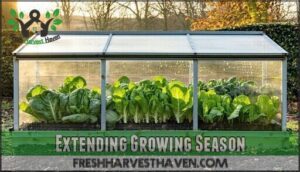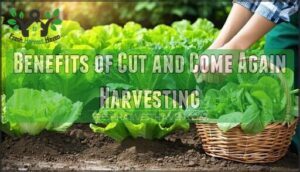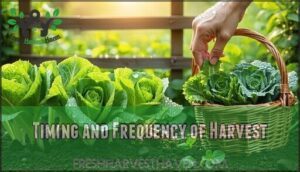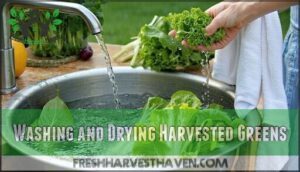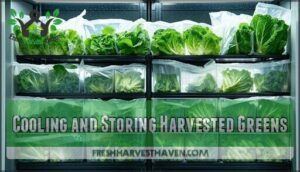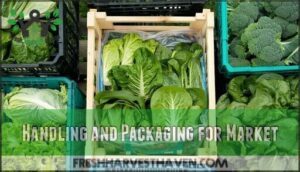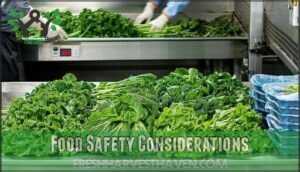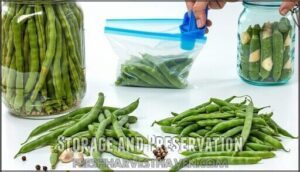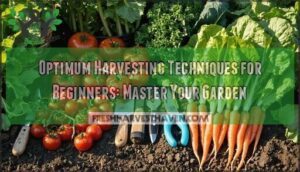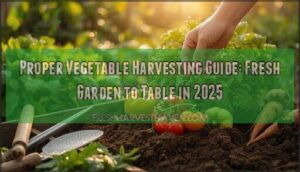This site is supported by our readers. We may earn a commission, at no cost to you, if you purchase through links.

The "cut-and-come-again" approach lets you snip outer leaves while keeping the center growing—perfect for lettuce, spinach, and kale.
For dense plantings like arugula or mesclun mix, try the "mow-down" method by cutting everything about an inch above soil level.
The "outside-in" technique works best for heading crops like cabbage, where you remove outer leaves first.
Timing matters: harvest in cool morning hours when leaves are crisp and full of moisture.
Most greens regrow within 2-3 weeks when you leave roots intact.
The secret lies in knowing exactly when each variety reaches peak flavor and nutritional density.
Table Of Contents
- Key Takeaways
- Harvesting Leafy Greens
- Extending Growing Season
- Harvest Timing and Yield
- Post-Harvest Handling
- Storage and Preservation
- Frequently Asked Questions (FAQs)
- How do you harvest leafy greens?
- Which greens are cut and come again?
- When to harvest green leaves?
- How to harvest spinach and kale?
- When to pick greens from the garden?
- How do you process leafy vegetables?
- How do you harvest greens so they keep growing?
- How do you harvest leafy vegetables?
- How do you pick leaf lettuce so it keeps growing?
- How do pests affect leafy green harvesting?
- Conclusion
Key Takeaways
- Choose the right harvesting method for each green – use cut-and-come-again for lettuce and spinach, mow-down for dense plantings like arugula, and outside-in for heading crops like cabbage
- Harvest at optimal times for best results – pick during cool morning hours when leaves are crisp and full of moisture, and harvest when you have enough crop to make picking worthwhile
- Use proper cutting techniques to encourage regrowth – cut outer leaves first with sharp scissors while leaving inner growth points intact, allowing plants to produce fresh harvests every 2-3 weeks
- Handle and store your harvest correctly – wash gently in cold water, cool immediately to 32-35°F with high humidity, and store properly to maintain crispness and nutritional value for weeks
Harvesting Leafy Greens
You’ll know it’s time to harvest your leafy greens when there’s enough crop to make picking worthwhile, typically when leaves reach eating size or heads form properly.
The key is choosing the right harvesting method for each type of green, whether you’re snipping individual leaves or cutting entire plants.
Suitable Greens for Harvest
Not all greens are created equal when planning your leafy green harvest.
Your garden’s superstars include:
- Baby Spinach: Quick-growing leaves perfect for tender salads and smoothies
- Fresh Arugula: Peppery micro greens ready in just days, adding zing to any dish
- Leafy Kale: The champion of kale harvesting, thriving through frost and regrowing reliably
Green Onions and collard greens also shine for continuous lettuce harvesting success.
Understanding best harvesting techniques is essential for maximizing yields and promoting healthy plant growth.
Harvesting Techniques and Methods
Three essential harvesting techniques guarantee maximum leafy green harvest success. Always sanitize your harvest tools before cutting—dirty equipment spreads disease faster than gossip. Use sharp scissors or knives for clean cuts that promote regrowth techniques.
Pro tip: Harvest during cool morning or evening hours when leaves stay crisp!
Cut outer leaves first, leaving inner growth points intact for seasonal planning. This cut and come again harvesting method keeps plants producing for months. Practice crop monitoring to time harvests perfectly—younger leaves taste sweeter, while mature ones pack more nutrients.
Smart harvesting means working with nature’s rhythm—patience pays off with continuous harvests!
Effective use of leafy green tools can substantially improve the harvesting process.
| Harvesting Methods | Best For | Frequency |
|---|---|---|
| Outer leaf picking | Kale, spinach | Weekly |
| Cut and come again | Lettuce, arugula | 10-14 days |
| Whole plant harvest | Cabbage, head lettuce | Once mature |
| Micro-green cutting | All varieties | 7-10 days |
| Selective thinning | Dense plantings | As needed |
Smart harvesting leafy greens means working with nature’s rhythm—patience pays off with continuous harvests!
Bottom-Up Harvesting Method
Bottom-up harvesting starts with cutting individual leaves from the plant’s base, working upward.
Select mature outer leaves using sharp harvest tools, leaving younger inner growth intact.
This leaf selection approach promotes continuous regrowth techniques while maintaining healthy soil management around the crown.
Monitor your crop regularly—you’ll get fresh harvests every few weeks when harvesting leafy green vegetables this way.
Outside-in Harvesting Method
While bottom-up works great, the outside-in harvesting method targets plants with rosette growth patterns. You’ll harvest outer leaves first, allowing the center to keep producing fresh growth.
Leaf Selection starts with mature outer leaves – they’re ready when firm and full-sized. Outer Harvest removes these leaves cleanly with sharp harvest tools, promoting continuous regrowth tips from the plant’s heart.
Harvesting techniques for outsidein harvesting include:
- Use clean scissors or knives for precise cuts
- Leave 2-3 inner leaves to maintain plant energy
- Harvest early morning when leaves are crisp and turgid
- Rotate harvest locations following crop rotation principles
- Check plants every 3-5 days during peak growing season
This harvesting method works perfectly for leafy greens like Swiss chard, spinach, and lettuce. Harvesting leafy green vegetables this way maximizes your garden’s productivity.
Mow-Down Harvesting Method
When dealing with dense plantings, mow-down harvesting lets you cut entire sections of leafy greens at once.
This harvesting method works perfectly for microgreens and baby salads where you’re after uniform cutting heights. Set your harvest tools about an inch above soil level to encourage leaf regrowth.
Different greens show varying regrowth rates – spinach bounces back faster than kale. This crop management technique maximizes efficiency when harvesting leafy green vegetables in commercial settings.
Extending Growing Season
You don’t have to stop growing leafy greens when summer heat arrives or winter frost threatens.
Smart gardeners use proven techniques like shade cloths, frost protection, and heat-tolerant varieties to harvest fresh greens year-round.
Growing in Cooler Seasons
Winter doesn’t mean the end of fresh greens. Cool season crops like kale, spinach, and arugula actually prefer chilly weather and can handle light frosts. These cold-hardy vegetables often taste sweeter after experiencing cold temperatures due to increased sugar content.
You can keep harvesting well into winter with proper frost protection. Row covers, hoop tunnels, and cold frames create microclimates that extend your growing season. Swiss chard and collards show remarkable resilience, continuing to produce even when temperatures drop.
- Mulch around plants to insulate roots and maintain soil temperature
- Install row covers before the first hard frost arrives
- Choose spinach varieties that can overwinter for early spring harvests
- Use cold frames to create warm pockets for continued growth
- Harvest during warmer parts of the day when leaves aren’t frozen
Understanding winter vegetable techniques is essential for a successful harvest.
Choosing Heat-Tolerant Varieties
When summer heat hits, smart variety selection keeps your harvest going strong.
Summer Spinach like Malabar thrives in warm temperatures while Jericho Lettuce and Nevada Lettuce resist bolting.
These heat-tolerant varieties extend your harvesting season for leafy vegetables.
Malabar Alternatives and loose-leaf types handle climate stress better than dense heads, ensuring continuous vegetable harvesting success.
Providing Partial Shade
Heat-tolerant varieties aren’t enough when summer blazes. You’ll need partial shade to shield your leafy greens from brutal afternoon sun. Shade cloth blocks 30-50% of sunlight while allowing air circulation. Position cloth overhead or create natural barriers with taller plants.
Shade Cloth Benefits include:
- Reduced heat stress and wilting
- Extended harvest period through summer
- Better leaf quality and tenderness
- Lower water requirements
- Protection from scorching UV rays
Remove shade during cooler seasons for maximum growth.
Maintaining Consistent Irrigation
Water stress kills more leafy greens than frost ever will. Your plants need steady moisture, not feast-or-famine cycles that leave them wilted and bitter.
Thirsty greens are bitter greens—consistency beats perfection every time.
Drip systems deliver water directly to roots, preventing waste and disease. Check soil moisture daily using your finger or a meter – it should feel like a wrung-out sponge. Irrigation scheduling means watering deeply but less frequently, encouraging strong root growth.
- Install drip systems for precise crop hydration without leaf wetness
- Monitor soil moisture levels 2-3 inches deep daily
- Schedule consistent irrigation during early morning hours
- Use mulch for water conservation and moisture control
- Maintain proper soil health through organic matter addition
Harvest Timing and Yield
You’ll maximize your harvest by understanding when and how often to pick your greens, since timing directly impacts both yield and plant longevity.
Getting the rhythm right means you can enjoy fresh greens for months instead of weeks from the same plants, which directly relates to the concept of maximizing your harvest.
Benefits of Cut and Come Again Harvesting
Cut and come again harvesting transforms your garden into nature’s renewable resource.
This technique involves harvesting outer leaves while leaving inner growth points intact, allowing continuous regrowth throughout the season.
Benefits of Cut and Come Again Method:
| Advantage | Traditional Harvest | Cut & Come Again |
|---|---|---|
| Leaf Yield | Single harvest per plant | 3-5 harvests per season |
| Harvest Frequency | Once every 60-90 days | Every 2-3 weeks |
| Regrowth Methods | Replant entirely | Trim outer leaves only |
This approach maximizes your leafy green vegetables output while maintaining soil health through extended root systems.
Continuous harvesting keeps plants productive longer, reducing the need for frequent crop rotation and replanting efforts.
Timing and Frequency of Harvest
Timing your harvest properly reveals the secret to continuous leafy green production.
Early mornings and cool evenings provide ideal conditions when leaves hold peak moisture and crispness.
- Growth Stages: Monitor plants weekly to catch leaves at their tender, flavorful prime before they become tough or bitter
- Harvest Intervals: Schedule regular picking every 7-14 days to maintain steady regrowth and prevent plants from bolting to seed
- Crop Monitoring: Track weather patterns and adjust harvest schedules accordingly—cooler seasons allow longer intervals between cuts
Consistent harvest timing maximizes both yield optimization and leaf quality throughout your growing season.
Yield Expectations for Heading Crops
Understanding heading crop yield expectations helps you plan effectively and maximize your harvest potential.
Head lettuce typically produces 400-500 crates per acre, while leafy varieties can reach 800-1,000 crates under ideal conditions.
Each crate contains 24 heads, making crop density vital for yield prediction.
To achieve maximum growth, farmers must consider the soil pH requirements for their specific lettuce variety.
| Crop Type | Yield Range |
|---|---|
| Iceberg Lettuce | 400-500 crates/acre |
| Leafy Varieties | 800-1,000 crates/acre |
| Cabbage | 85 heads/100 feet |
Proper harvest scheduling and crop monitoring guarantee you’ll hit these targets consistently, and help you understand the importance of maximize your harvest potential.
Factors Affecting Yield and Quality
Several key elements determine your leafy greens’ success beyond just soil quality and variety choice.
Water stress from inconsistent irrigation reduces both crop yield and leaf firmness. Climate factors like unexpected heat waves or heavy rainfall can devastate entire harvests overnight.
Here are four critical factors affecting your harvest:
- Nutrient balance – Over-fertilizing creates lush but weak leaves
- Crop density – Overcrowding reduces air circulation and promotes disease
- Harvesting techniques – Rough handling bruises leaves and shortens shelf life
- Postharvest handling – Quick cooling preserves quality and factors affecting yield
Understanding proper harvesting methods is essential for maximizing leafy green yields.
Post-Harvest Handling
Once you’ve harvested your leafy greens, proper handling becomes essential for maintaining freshness and preventing spoilage.
The first few hours after picking determine whether your greens stay crisp for days or turn into soggy disappointments by tomorrow.
Washing and Drying Harvested Greens
Once you’ve picked your greens, Cold Water Washing removes dirt and debris effectively. Rinse leaves gently—don’t bruise them!
Leaf Sanitizing with clean tools prevents contamination during postharvest handling. Use a salad spinner for Moisture Removal or pat dry with clean towels.
Gentle Drying prevents spoilage since wet leaves deteriorate quickly. Proper Greens Cleaning and drying techniques dramatically improve storage life and maintain that garden-fresh crispness you’ve worked hard to achieve.
Effective leaf cleaning often involves using specialized leaf washing tools to remove dirt and debris.
Cooling and Storing Harvested Greens
Once you’ve washed your greens, Cold Storage becomes your best friend for preserving that garden-fresh quality.
The cooling process starts immediately—aim for temperatures between 32°F to 35°F with Humidity Control at 98-100%. This refrigeration sweet spot extends Shelf Life dramatically.
Fresh Handling means understanding your storage needs:
- Use Green Packaging like perforated plastic bags with damp paper towels
- Store in sealed containers with a splash of water for moisture
- Cool harvested greens within hours, not days, for ideal postharvest storage
Think of it as putting your greens into hibernation—they’ll stay crisp and ready for weeks when you nail the temperature and humidity combo.
Handling and Packaging for Market
Once your greens are cooled, Market Preparation begins with selecting proper Packaging Materials.
Use breathable containers or perforated bags for air circulation. Bundle greens with rubber bands, avoiding tight compression that damages leaves.
Choose clear sleeves meeting food safety standards. Gentle handling prevents bruising while maintaining Freshness Preservation.
Quality packaging protects during transport, ensuring your crisp, vibrant greens reach customers in peak condition.
Food Safety Considerations
Proper handling practices protect your harvest and consumers from contamination risk. Once you’ve packaged your greens, food safety becomes your top priority—think of it as building a protective shield around your hard work.
- Maintain temperature control below 40°F to slow bacterial growth and extend shelf life
- Follow handling protocols with clean hands, sanitized tools, and proper storage containers
- Use potable water only for washing—contaminated water sources pose serious health risks
- Keep sick workers away from harvest areas to prevent pathogen transmission
- Document everything for farm audits and regulatory compliance requirements
Understanding proper storage techniques is essential for maintaining the quality of your leafy greens. Consumer education starts with your commitment to contamination protection through proven safety standards.
Storage and Preservation
You’ll want to store your freshly harvested greens properly to maintain their crisp texture and nutritional value for weeks.
Whether you choose refrigeration, freezing, or preservation methods like fermentation, the right storage technique can turn your garden bounty into a year-round supply of healthy greens.
Refrigeration and Humidity Control
Through proper cooling systems and temperature management, you’ll maintain your greens’ freshness by storing them at 32°F to 35°F.
Refrigeration units with humidity control create the ideal 98%-100% moisture environment.
Storage solutions like sealed bags prevent moisture retention loss while humidity regulation blocks ethylene exposure.
These refrigeration temperature settings keep leaves crisp for days.
Freezing and Dehydrating Options
When refrigeration isn’t enough, freezing and dehydrating extend your harvest for months.
Blanch greens 1-2 minutes before flash freezing to preserve nutrients and color. Vacuum packing prevents freezer burn.
For dehydrating, use your dehydrator at 122-131°F for 6-8 hours.
Both food preservation methods retain most vitamins while giving you year-round greens for cooking.
Proper use of freezing containers is essential for maintaining the quality of frozen leafy greens.
Fermenting and Pickling Methods
Beyond freezing and dehydrating, fermenting and pickling transform your leafy greens into tangy treasures that’ll last months.
These food preservation methods pack probiotics and bold flavors into every bite.
- Lactofermentation magic: Massage pickling salt into sturdy greens like cabbage or kale, creating natural brine that ferments without vinegar
- Quick pickling power: Blanch delicate greens briefly, then submerge in hot brine recipes with your favorite canning methods and spices
- Fermentation tips for success: Keep vegetables submerged under brine, store in cool spots, and taste-test your creations after a few days
These ancient techniques turn ordinary greens into probiotic powerhouses.
Maintaining Quality and Freshness
Once your Freshness Tips adventure wraps up, maintaining peak Quality Control becomes your next mission.
Store harvested leafy greens at 32-35°F with high humidity to prevent wilting. Handle your fresh produce gently—bruised leaves spoil faster than forgotten leftovers.
Green Handling matters during postharvest care; rough treatment shortens shelf life. Monitor your Leafy Storage conditions regularly through Crop Monitoring.
Sustainable harvesting means protecting quality from garden to table, ensuring your harvesting leafy greens efforts pay off with crisp, vibrant vegetables. Understanding proper storage techniques is essential for maintaining freshness and quality in harvested produce.
Frequently Asked Questions (FAQs)
How do you harvest leafy greens?
Timing’s everything when you’re ready to harvest. Use sharp scissors to cut outer leaves first, leaving inner ones to keep growing. Harvest early morning for crispest greens.
Which greens are cut and come again?
Kale’s your champion for cut-and-come-again harvesting.
You’ll pick outer leaves while the center keeps producing.
Spinach, Swiss chard, arugula, and lettuce also regrow after harvesting, extending your garden’s productivity throughout the season, which makes them ideal for continuous harvesting.
When to harvest green leaves?
Like morning dew signaling dawn’s arrival, your greens whisper readiness through size and timing.
Harvest when you’ve got enough to make picking worthwhile—young leaves for tender salads, mature ones for bold flavors.
How to harvest spinach and kale?
Cut outer leaves first using sharp scissors, leaving the center to regrow. Harvest spinach when leaves reach 3-4 inches, kale until first hard frost arrives.
When to pick greens from the garden?
Pick greens when you’ve got enough to make harvesting worthwhile. Young leaves work perfectly for salads, while mature ones offer stronger flavors for cooking adventures.
How do you process leafy vegetables?
Wash your greens gently in cold water, then dry thoroughly. Cool them quickly to 32-35°F, store in sealed plastic bags with high humidity, and refrigerate immediately.
How do you harvest greens so they keep growing?
Harvest outer leaves first with sharp scissors, leaving the center intact. Cut about one inch above soil level for baby greens to encourage regrowth and continuous harvesting.
How do you harvest leafy vegetables?
Begin early morning when leaves are crisp and cool. Use sharp scissors to snip outer leaves first, cutting about an inch above soil level to encourage regrowth and continuous harvests.
How do you pick leaf lettuce so it keeps growing?
Cut outer leaves first, then inner ones, leaving the growing center intact—you’ll encourage continuous regrowth while enjoying fresh lettuce throughout the season.
How do pests affect leafy green harvesting?
Pests damage leaves, creating holes and spots that make harvesting worthless. You’ll need to inspect carefully, removing affected plants to prevent spread and maintain quality standards for safe consumption.
Conclusion
Surprisingly, many gardeners complicate what should be simple: harvesting leafy green vegetables.
You’ve learned three straightforward methods that’ll keep your plants producing for months.
Master the timing—cool mornings yield crisp, flavorful leaves—and you’ll harvest pounds from small spaces.
Whether you’re growing spinach or kale, these techniques guarantee continuous harvests while maintaining nutritional quality.
Your patience with proper harvesting leafy green vegetables pays off with extended seasons and maximum yields from every plant.
- https://www.lsuagcenter.com/articles/page1654800072121
- https://piedmontmastergardeners.org/article/growing-leafy-greens/
- https://growingformarket.com/articles/winter-vegetables
- https://www.ishs.org/ishs-article/1377_2
- https://hortamericas.com/blog/news/monitoring-is-crucial-for-growing-lettuce-and-leafy-greens-year-round/

